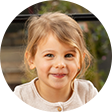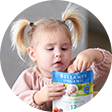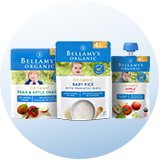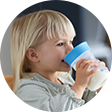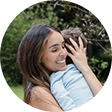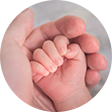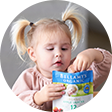How to Improve Your Child’s Hand-Eye Coordination
Hand-eye coordination is the body’s ability to process information received through the eyes and use it to direct movements of the hands to complete a task or skill. It works in relation to both fine-motor skills (e.g. picking something up) and gross-motor skills (e.g. learning to walk). Hand-eye coordination develops naturally as your child grows. As a newborn, hand movements are mainly reflexive, but as they grow and develop their curiosity, movements become more purposeful — like reaching for things they want to touch. However there are things you can do with your baby to help strengthen their coordination from an early age. Children develop at different rates due to many factors such as exposure to other children like siblings and kindergarten, play time with carers, and their natural curiosity levels. The following table from Raising Children Australia provides coordination by age. Don't worry if your child doesn’t fall into these categories! Children will grow and develop at their own rates, all we can do is encourage them and provide opportunities for learning.
Typical Hand-Eye Coordination Development by Age
| Age | Coordination Development |
| 5 months old | - Grasping for objects - Moving things from one hand to the other |
| 1 year old | - Displaying pincer grasp - Picking up smaller objects |
| 2 years old | - Picking up and stacking 5 building blocks - Hold a writing utensil - Hold a spoon to eat |
| 3 years old | - Turning pages in a book - Drawing circles |
| 4 – 5 years old | - Demonstrating spacial awareness through intentioned placement of small objects - Better control of eating utensils |
| 5-7 years old | - Writing individual letters - Colouring within lines - Doing up zippers and buttons - Move and manipulate objects easily - Eventual skill development into sport playing such as tennis or football |
There are many ways to encourage development of hand-eye coordination, and for babies, play is an essential part. Play allows your baby to learn how to reach and grab for objects, as well as understand cause and effect. In early childhood repetition forms the basis of learning, and the more time spent practising something the easier it will become. So play lots and encourage them to do things over and over (if they’re enjoying the game they’ll probably be the ones encouraging you!).
Developing hand-eye coordination
For babies, try:
- placing objects of interest within reach
- sing Incy Wincey Spider or Twinkle Twinkle Little Star and do the finger actions for them to mimic
- shaking a rattle or plastic keys
- playing with toys that make noise
- attaching wrist rattles
- building a tower for baby to knock down
For toddlers, try:
- throwing and catching a ball
- colouring in activities
- connect-the-dot activities
- stringing beads
- jigsaw puzzles (not too many pieces, check the age recommendation)
- bouncing balls
- tossing a small bean bag into a hula hoop
- rolling a ball to hit down bottles
- finger painting
For children five years+, try:
- bouncing a ball on a racquet
- kicking a ball into a goal
- baking (e.g. measuring a cup of flour)
- wall ball
- juggling
- hopscotch (you can use chalk to draw the game on the street)
- tennis
- over and under throwing
- jigsaw puzzles
- Lego
- Jenga
- relay races
Give some of these exercises and games a try, just make sure to pick activities from the right age group! Your children will love simply spending time with you; learning and developing hand-eye coordination is a bonus. And the best part is they won't realise they’re learning, to them it’s just fun. If you have concerns about your child’s hand-eye coordination, consider speaking with their paediatrician to assess their progress.
References
1. Hand-eye coordination and readiness to learn (2021). State Library of Queensland. Available at: https://www.slq.qld.gov.au/blog/hand-eye-coordination-and-readiness-learn (Accessed: 23 August 2021).
2. Montessori, M., 2017. Repetition and child development in Montessori Education. Montessori Academy.
3. 3-4 months: baby development (2021). Raising Children. Available at: https://raisingchildren.net.au/babies/development/development-tracker-3-12-months/3-4-months (Accessed: 23 August 2021).
4. Toddlers: play & learning (2021). Raising Children. Available at: https://raisingchildren.net.au/toddlers/play-learning (Accessed: 25 August 2021).
5. Johansson, R. et al. (2001) "Eye–Hand Coordination in Object Manipulation", The Journal of Neuroscience, 21(17), pp. 6917-6932. doi: 10.1523/jneurosci.21-17-06917.2001.
6. https://bellamysorganic.com.au/blog/category/articles/
7. https://bellamysorganic.com.au/blog/how-to-improve-your-childs-hand-eye-coordination/






